Combining Reclaimed Asphalt Pavement (RAP) and Recycled Concrete Aggregate (RCA) from Cuba to Obtain a Coarse Aggregate Fraction
Abstract
1. Introduction
2. Materials and Methods
2.1. Materials
- RCA-PCFM1: from the loose material left in the concrete mixer, or spilled in the production process of the reinforced concrete precast core floor slabs, and then sieved in 5–10 mm fraction.
- RCA-PCFM2: from the loose material left in the concrete mixer or spilled in the production process of reinforced concrete precast core floor slabs larger than 10 mm; it was crushed in a jaw crusher and then sieved in 5–10 mm fraction.
- RCA-PCFM3: from the loose material left in the concrete mixer or spilled in the production process of reinforced concrete precast core floor slabs, which was crushed in a jaw crusher and sieved to obtain particles of 5–10 mm.
- RCA-PCF: coming from the crushing of reinforced concrete precast core floor slabs that have been broken in the storage process, or do not present the required quality. The waste was reduced to a size smaller than 30 cm with a rotary hammer, manually extracting the pre-stressed steel. Then, the blocks were crushed in a jaw crusher, the obtained material having a size of 5–10 mm.
- RCA-SW: the waste remaining of the demolition of the sidewalk was first crushed with a rotary hammer until obtaining a maximum size of 30 cm. Then, the blocks were introduced in a jaw crusher for obtaining particles with a size of 5–10 mm.
2.2. Methodology
3. Results and Discussion
3.1. Recycled Concrete Aggregates (RCA) Characterization
3.1.1. Particle Density and Water Absorption
3.1.2. Elongated Particles
3.2. Reclaimed Asphalt Pavement (RAP) Characterization
3.2.1. Particle Density and Water Absorption
3.2.2. Elongated Particles
3.3. RCA/RAP Combination
- 0/100: 0% RCA and 100% RAP.
- 25/75: 25% RCA and 75% RAP.
- 50/50: 50% RCA and 50% RAP.
- 75/25: 75% RCA and 25% RAP.
- 100/0: 100% RCA and 0% RAP.
3.3.1. Particle Density and Water Absorption
3.3.2. Elongated Particles
3.4. Statistical Analysis
4. Conclusions
- The detachment of the adhered mortar of the RCA samples crushed caused differences with the RCA samples without crushing.
- The samples RCA-PCF and RCA-SW were less dense and more porous aggregates, probably because they come from industrial wastes and they had a lower detachment of mortar.
- RAP samples exhibited results similar to those obtained in NA.
- RCA, RAP, and the different combinations studied, had lower specific gravity and higher water absorption than NA.
- The combinations of RCA and RAP influenced the values in the properties studied. The results obtained with a 25% of RCA and 75% of RAP combination were similar to NA.
Author Contributions
Funding
Acknowledgments
Conflicts of Interest
Nomenclature
| RCA | Recycled concrete aggregates |
| CDW | Construction and demolition waste |
| AC | Asphalt concrete |
| OAC | Optimum asphalt content |
| NA | Natural aggregate |
References
- Ossa, A.; García, J.L.; Botero, E. Use of recycled construction and demolition waste (CDW) aggregates: A sustainable alternative for the pavement construction industry. J. Clean. Prod. 2016, 135, 379–386. [Google Scholar] [CrossRef]
- European Commission (EC) EU Construction & Demolition Waste Management Protocol. Off. J. Eur. Union. 2008, 1, 1–61.
- González-Taboada, I.; González-Fonteboa, B.; Martínez-Abella, F.; Carro-López, D. Study of recycled concrete aggregate quality and its relationship with recycled concrete compressive strength using database analysis. Mater. Constr. 2016, 66, e089. [Google Scholar] [CrossRef]
- Shi, C.; Li, Y.; Zhang, J.; Li, W.; Chong, L.; Xie, Z. Performance enhancement of recycled concrete aggregate—A review. J. Clean. Prod. 2016, 112, 466–472. [Google Scholar] [CrossRef]
- Padmini, A.K.; Ramamurthy, K.; Mathews, M.S. Influence of parent concrete on the properties of recycled aggregate concrete. Constr. Build. Mater. 2009, 23, 829–836. [Google Scholar] [CrossRef]
- Silva, R.V.; De Brito, J.; Dhir, R.K. Properties and composition of recycled aggregates from construction and demolition waste suitable for concrete production. Constr. Build. Mater. 2014, 65, 201–217. [Google Scholar] [CrossRef]
- Mills-Beale, J.; You, Z. The mechanical properties of asphalt mixtures with Recycled Concrete Aggregates. Constr. Build. Mater. 2010, 24, 230–235. [Google Scholar] [CrossRef]
- Paranavithana, S.; Mohajerani, A. Effects of recycled concrete aggregates on properties of asphalt concrete. Resour. Conserv. Recycl. 2006, 48, 1–12. [Google Scholar] [CrossRef]
- Etxeberria, M.; Vázquez, E.; Marí, A.; Barra, M.; Vazquez, E.; Mari, A.; Barra, M. Influence of amount of recycled coarse aggregates and production process on properties of recycled aggregate concrete. Cem. Concr. Res. 2007, 37, 735–742. [Google Scholar] [CrossRef]
- Pasandín, A.R.; Pérez, I. Overview of bituminous mixtures made with recycled concrete aggregates. Constr. Build. Mater. 2015, 74, 151–161. [Google Scholar] [CrossRef]
- Varona, F.B.; Baeza-Brotons, F.; Tenza-Abril, A.J.; Baeza, F.J.; Bañón, L. Residual Compressive Strength of Recycled Aggregate Concretes after High Temperature Exposure. Materials 2020, 13, 1981. [Google Scholar] [CrossRef] [PubMed]
- Santos, W.F.; Quattrone, M.; John, V.M.; Angulo, S.C. Roughness, wettability and water absorption of water repellent treated recycled aggregates. Constr. Build. Mater. 2017, 146, 506–513. [Google Scholar] [CrossRef]
- Qiao, Y.; Dave, E.; Parry, T.; Valle, O.; Mi, L.; Ni, G.; Yuan, Z.; Zhu, Y. Life cycle costs analysis of reclaimed asphalt pavement (RAP) under future climate. Sustainability 2019, 11, 5414. [Google Scholar] [CrossRef]
- Plati, C.; Cliatt, B. A sustainability perspective for unbound reclaimed asphalt pavement (RAP) as a pavement base material. Sustainability 2018, 11, 78. [Google Scholar] [CrossRef]
- Aurangzeb, Q.; Al-Qadi, I.L. Asphalt pavements with high reclaimed asphalt pavement content: Economic and environmental perspectives. Transp. Res. Rec. 2014, 2456, 16. [Google Scholar] [CrossRef]
- Han, S.; Cheng, X.; Liu, Y.; Zhang, Y. Laboratory Performance of Hot Mix Asphalt with High Reclaimed Asphalt Pavement (RAP) and Fine Reclaimed Asphalt Pavement (FRAP) Content. Materials 2019, 12, 2536. [Google Scholar] [CrossRef] [PubMed]
- Montañez, J.; Caro, S.; Carrizosa, D.; Calvo, A.; Sánchez, X. Variability of the mechanical properties of Reclaimed Asphalt Pavement (RAP) obtained from different sources. Constr. Build. Mater. 2020, 230, 116968. [Google Scholar] [CrossRef]
- Radević, A.; Isailović, I.; Wistuba, M.P.; Zakić, D.; Orešković, M.; Mladenović, G. The Impact of Recycled Concrete Aggregate on the Stiffness, Fatigue, and Low-Temperature Performance of Asphalt Mixtures for Road Construction. Sustainability 2020, 12, 3949. [Google Scholar] [CrossRef]
- Álvarez, D.A.; Aenlle, A.A.; Tenza-Abril, A.J.; Ivorra, S. Influence of partial coarse fraction substitution of natural aggregate by recycled concrete aggregate in hot asphalt mixtures. Sustainability 2020, 12, 250. [Google Scholar] [CrossRef]
- Alvarez, D.A.; Aenlle, A.A.; Tenza-Abril, A.J.; Acosta, D.; Alonso, A.; Tenza, A.J. Laboratory evaluation of hot asphalt concrete properties with Cuban recycled concrete aggregates. Sustainability 2018, 10, 2590. [Google Scholar] [CrossRef]
- Al-Bayati, H.K.A.; Tighe, S.L.; Achebe, J. Influence of recycled concrete aggregate on volumetric properties of hot mix asphalt. Resour. Conserv. Recycl. 2018, 130, 200–214. [Google Scholar] [CrossRef]
- Wu, S.; Muhunthan, B.; Wen, H. Investigation of effectiveness of prediction of fatigue life for hot mix asphalt blended with recycled concrete aggregate using monotonic fracture testing. Constr. Build. Mater. 2017, 131, 50–56. [Google Scholar] [CrossRef]
- Tam, V.W.Y.; Soomro, M.; Evangelista, A.C.J. A review of recycled aggregate in concrete applications (2000–2017). Constr. Build. Mater. 2018, 172, 272–292. [Google Scholar] [CrossRef]
- Topini, D.; Toraldo, E.; Andena, L.; Mariani, E. Use of recycled fillers in bituminous mixtures for road pavements. Constr. Build. Mater. 2018, 159, 189–197. [Google Scholar] [CrossRef]
- Tenza-Abril, A.J.; Saval, J.M.; Cuenca, A. Using Sewage-Sludge Ash as Filler in Bituminous Mixes. J. Mater. Civ. Eng. 2015, 27. [Google Scholar] [CrossRef]
- Tenza-Abril, A.; Saval, J.; García-Vera, V.; Solak, A.; Real Herráiz, T.; Ortega, J. Effects of Using Mine Tailings from La Unión (Spain) in Hot Bituminous Mixes Design. Appl. Sci. 2019, 9, 272. [Google Scholar] [CrossRef]
- Tahmoorian, F.; Samali, B.; Tam, V.W.Y.; Yeaman, J. Evaluation of mechanical properties of recycled material for utilization in asphalt mixtures. Appl. Sci. 2017, 7, 763. [Google Scholar] [CrossRef]
- Chen, J.S.; Liao, M.C. Evaluation of internal resistance in hot-mix asphalt (HMA) concrete. Constr. Build. Mater. 2002, 16, 313–319. [Google Scholar] [CrossRef]
- Sengoz, B.; Onsori, A.; Topal, A. Effect of aggregate shape on the surface properties of flexible pavement. KSCE J. Civ. Eng. 2014, 18, 1364–1371. [Google Scholar] [CrossRef]
- Fernández-Fanjul, A.; Tenza-Abril, A.J.; Baeza-Brotons, F. A new methodology for determining particle density and absorption of lightweight, normal-weight and heavy weight aggregates in aqueous medium. Constr. Build. Mater. 2017, 146, 630–643. [Google Scholar] [CrossRef]
- Fernández-Fanjul, A.; Tenza-Abril, A.J.; Baeza-Brotons, F. A new methodology for determining water absorption of lightweight, normal-weight and heavyweight aggregates in a viscous medium. Constr. Build. Mater. 2018, 165, 596–607. [Google Scholar] [CrossRef]
- Li, Z.; Liu, J.; Xiao, J.; Zhong, P. A method to determine water absorption of recycled fine aggregate in paste for design and quality control of fresh mortar. Constr. Build. Mater. 2019, 197, 30–41. [Google Scholar] [CrossRef]
- Rossi, E.; Sebastiani, M.; Gigliotti, R.; D’Amato, M. An Innovative Procedure for the In-situ Characterization of Elastomeric Bearings by Using Nanoindentation Test. Int. J. Archit. Herit. 2020. [Google Scholar] [CrossRef]
- Oliver, W.C.; Pharr, G.M. Nanoindentation in materials research: Past, present, and future. MRS Bull. 2010, 35, 897–907. [Google Scholar] [CrossRef]
- Pérez, I.; Pasandín, A.R. Moisture damage resistance of hot-mix asphalt made with recycled concrete aggregates and crumb rubber. J. Clean. Prod. 2017, 165, 405–414. [Google Scholar] [CrossRef]
- Thomas, C.; de Brito, J.; Cimentada, A.; Sainz-Aja, J.A. Macro- and micro- properties of multi-recycled aggregate concrete. J. Clean. Prod. 2020, 245, 118843. [Google Scholar] [CrossRef]
- Guo, H.; Shi, C.; Guan, X.; Zhu, J.; Ding, Y.; Ling, T.C.; Zhang, H.; Wang, Y. Durability of recycled aggregate concrete—A review. Cem. Concr. Compos. 2018, 89, 251–259. [Google Scholar] [CrossRef]
- Pasandín, A.R. Sensibilidad al Agua y Propiedades Mecánicas de Mezclas Bituminosas en Caliente Fabricadas con áridos Reciclados de Residuos de Construcción y Demolición; Universidade da Coruña: A Coruña, Spain, 2013. [Google Scholar]
- Bautista, E.G.; Flickinger, J.; Saha, R.; Flores-Vivian, I.; Faheem, A.F.; Sobolev, K. Effect of Coal Combustion Products on high temperature performance of asphalt mastics. Constr. Build. Mater. 2015. [Google Scholar] [CrossRef]
- Sharma, V.; Chandra, S.; Choudhary, R. Characterization of fly ash bituminous concrete mixes. J. Mater. Civ. Eng. 2010, 22. [Google Scholar] [CrossRef]
- Chew, J.W.; Poovaneshvaran, S.; Hasan, M.R.M.; Hamzah, M.O.; Valentin, J.; Sani, A. Microscopic analysis and mechanical properties of Recycled Paper Mill Sludge modified asphalt mixture using granite and limestone aggregates. Constr. Build. Mater. 2020, 243, 118172. [Google Scholar] [CrossRef]
- NLT-359/87 Áridos. Determinación de la Humedad Total por Secado; Centro de estudios de carreteras y experimentación de obras públicas: Madrid, España, 1987.
- NLT-164/90. Contenido de Ligante en Mezclas Bituminosas; Centro de estudios de carreteras y experimentación de obras públicas: Madrid, España, 1990.
- Federal Highway Administration Research and Technology. FHWA-RD-97-148 User Guidelines for by Product and Secondary Use Materials in Pavement Construction; Federal Highway Administration: Washington, DC, USA, 2008.
- NC 187 Arido Gruesos. Peso Especifico y Absorción de Agua; Oficina Nacional de Normalización: La Habana, Cuba, 2002.
- NC 189 Áridos gruesos. Detreminación de Partículas Planas y Alargadas; Oficina Nacional de Normalización: La Habana, Cuba, 2002.
- NC 253 Carreteras Materiales Bituminosos. Hormigón Asfáltico Caliente; Oficina Nacional de Normalización: La Habana, Cuba, 2005.
- de Juan, M.S.; Gutiérrez, P.A. Study on the influence of attached mortar content on the properties of recycled concrete aggregate. Constr. Build. Mater. 2009, 23, 872–877. [Google Scholar] [CrossRef]
- Wang, R.; Yu, N.; Li, Y. Methods for improving the microstructure of recycled concrete aggregate: A review. Constr. Build. Mater. 2020, 242, 118164. [Google Scholar] [CrossRef]
- Echeverría, I.R. Caracterización de áridos Reciclados Tipo Hormigón Para Mezclas Asfálticas en Caliente; Universidad Tecnológica de La Habana José Antonio Echeverría: Havana, Cuba, 2018. [Google Scholar]
- Ruxton, G.D.; Beauchamp, G. Time for some a priori thinking about post hoc testing. Behav. Ecol. 2008, 19, 690–693. [Google Scholar] [CrossRef]
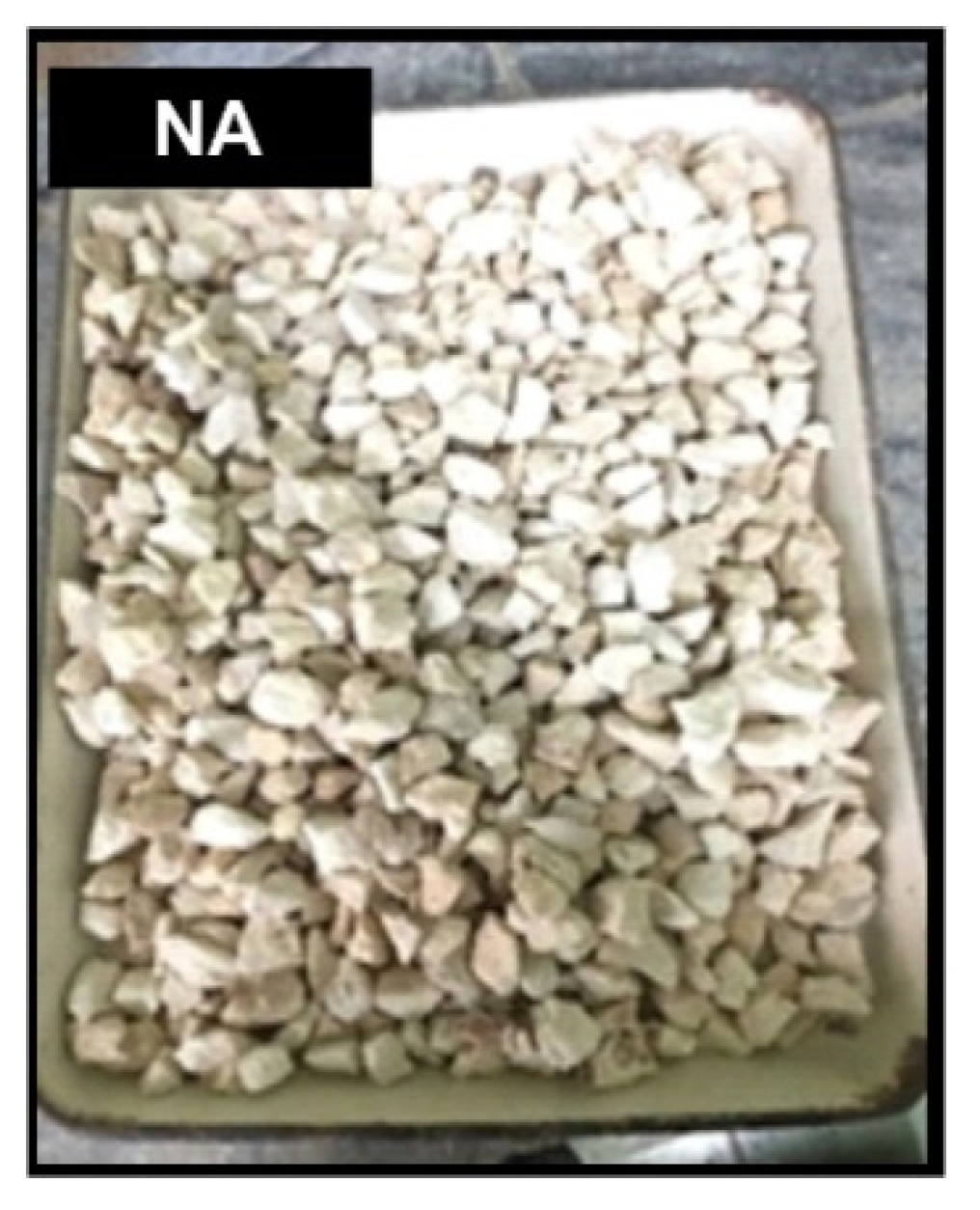
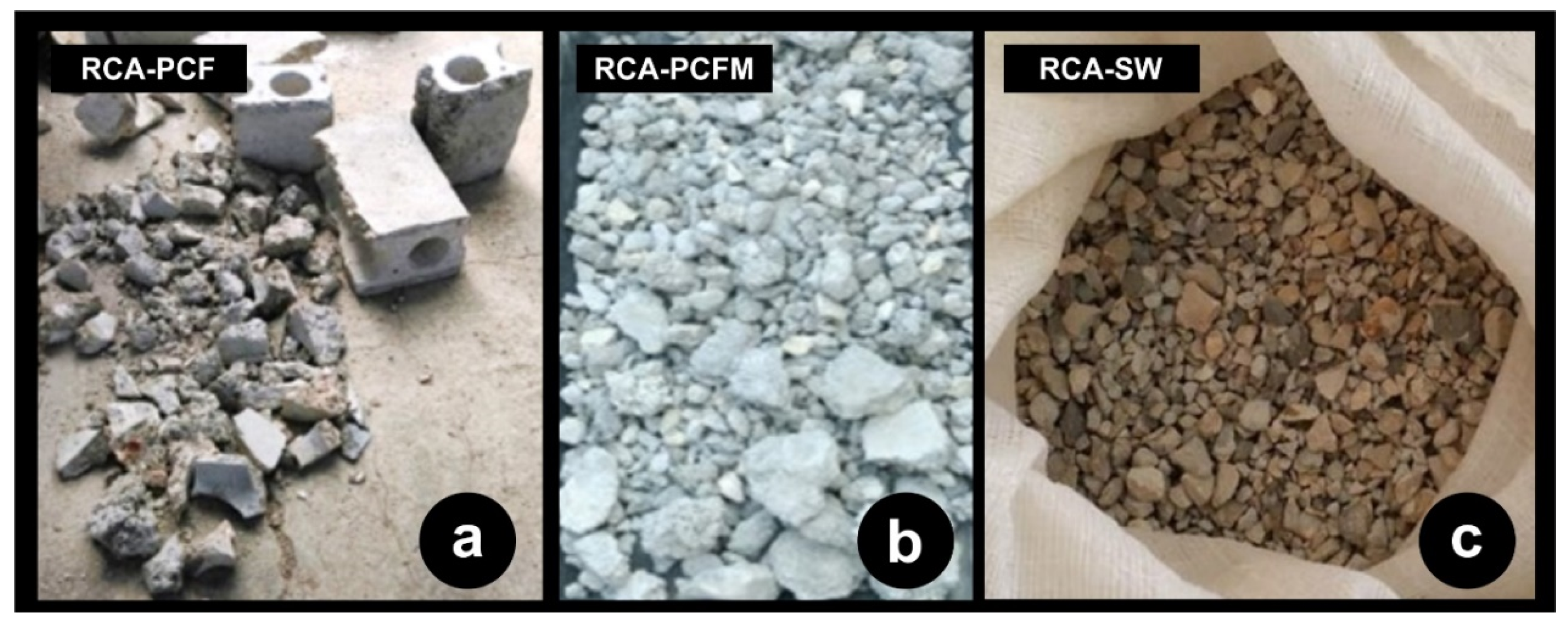
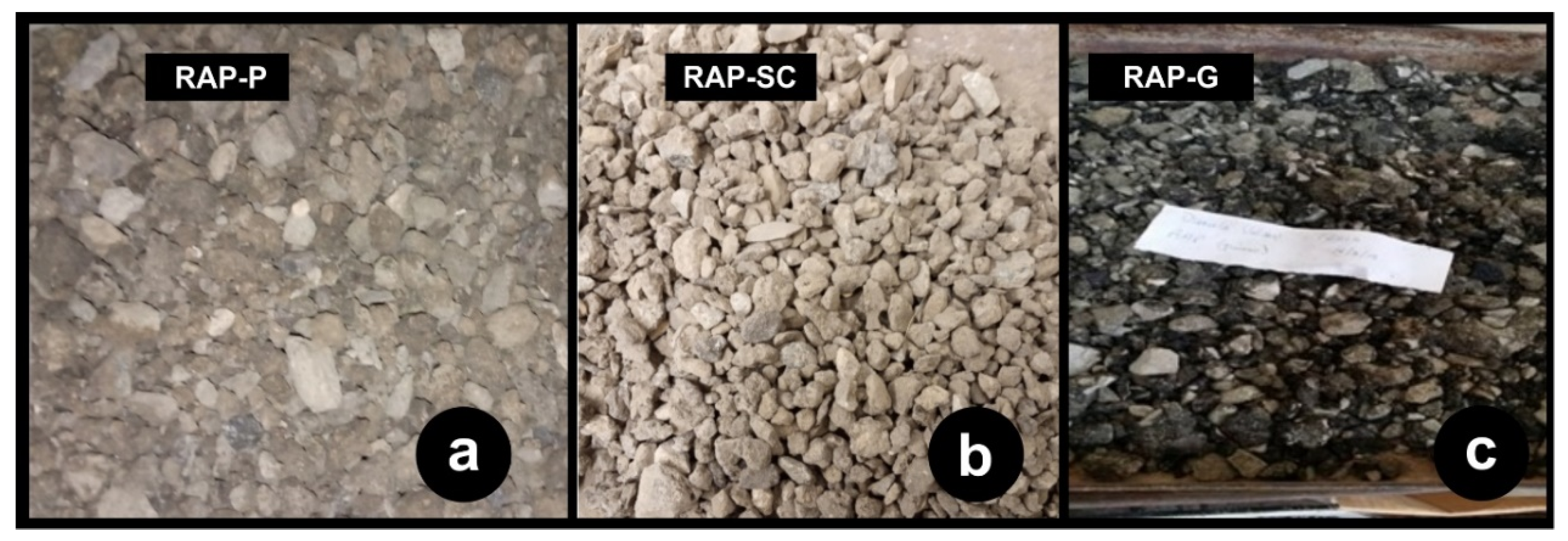
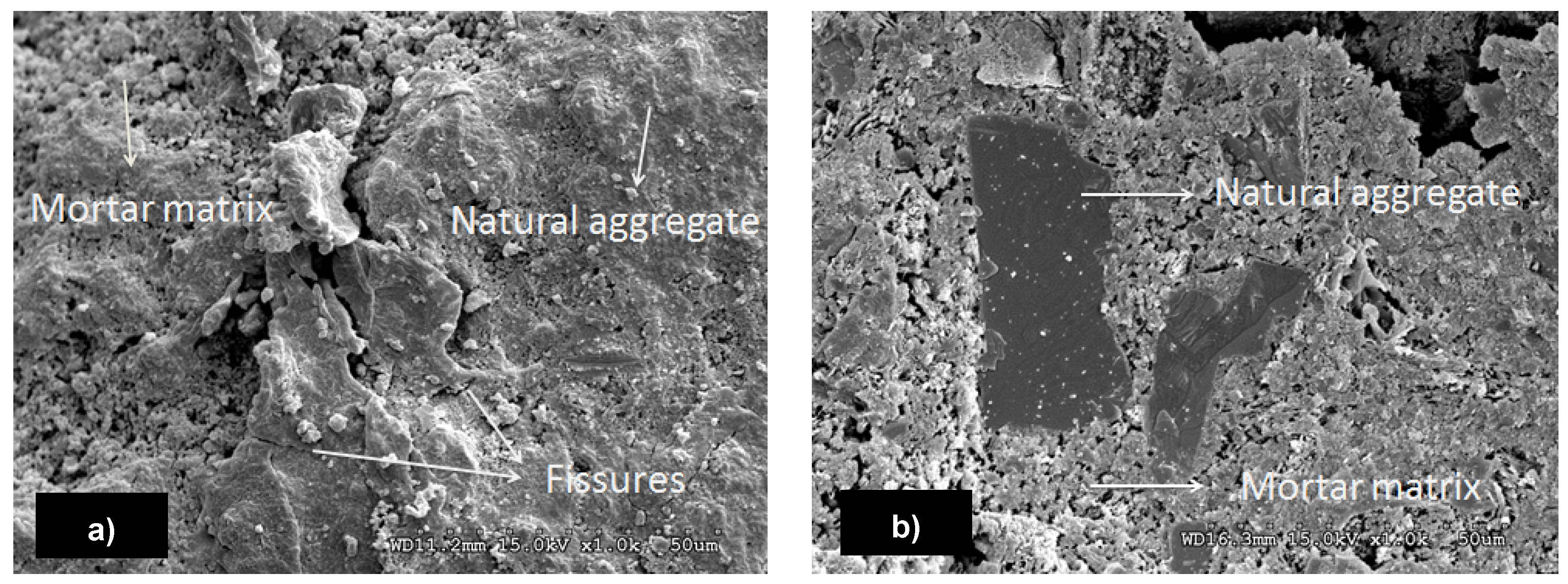
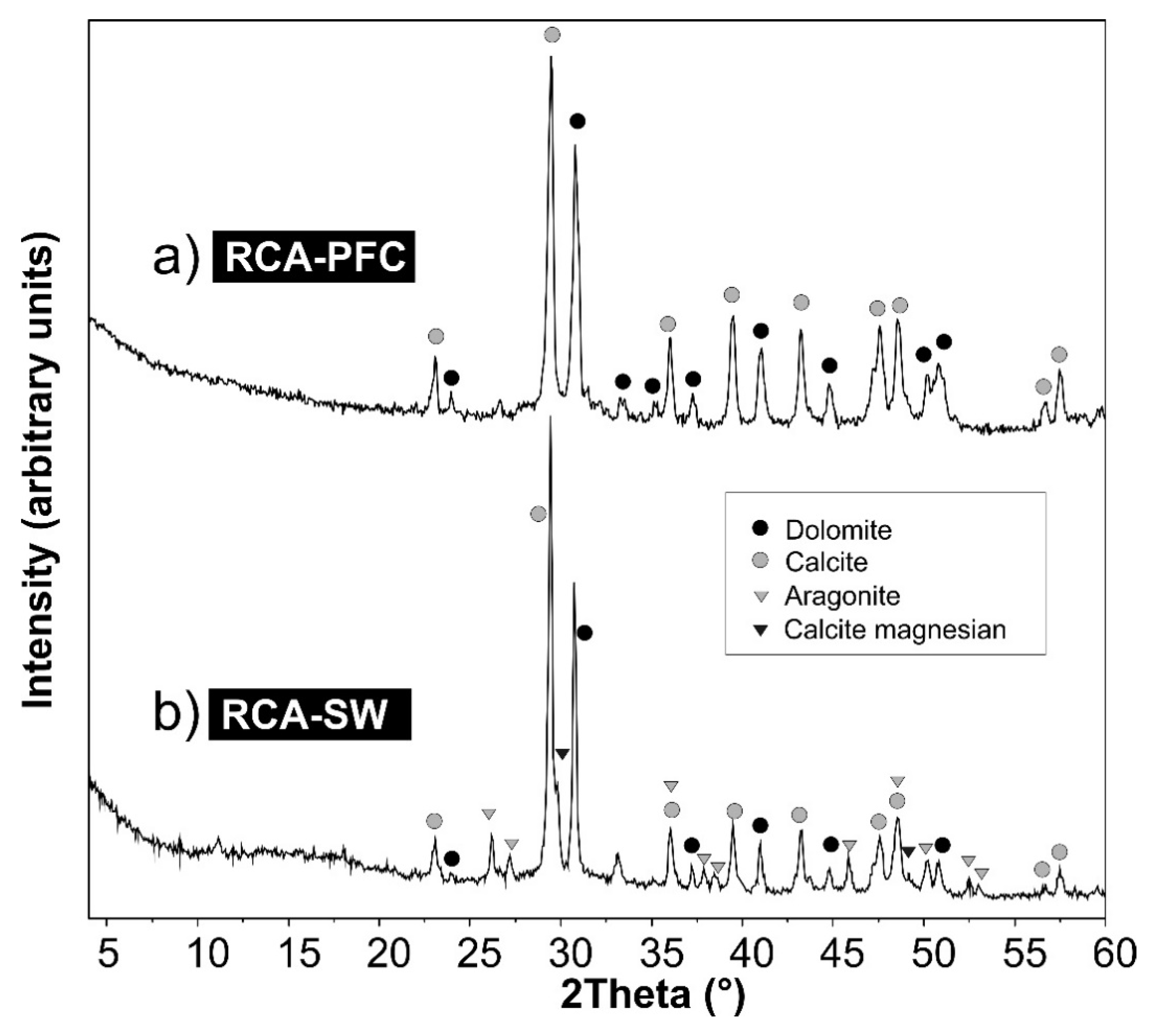
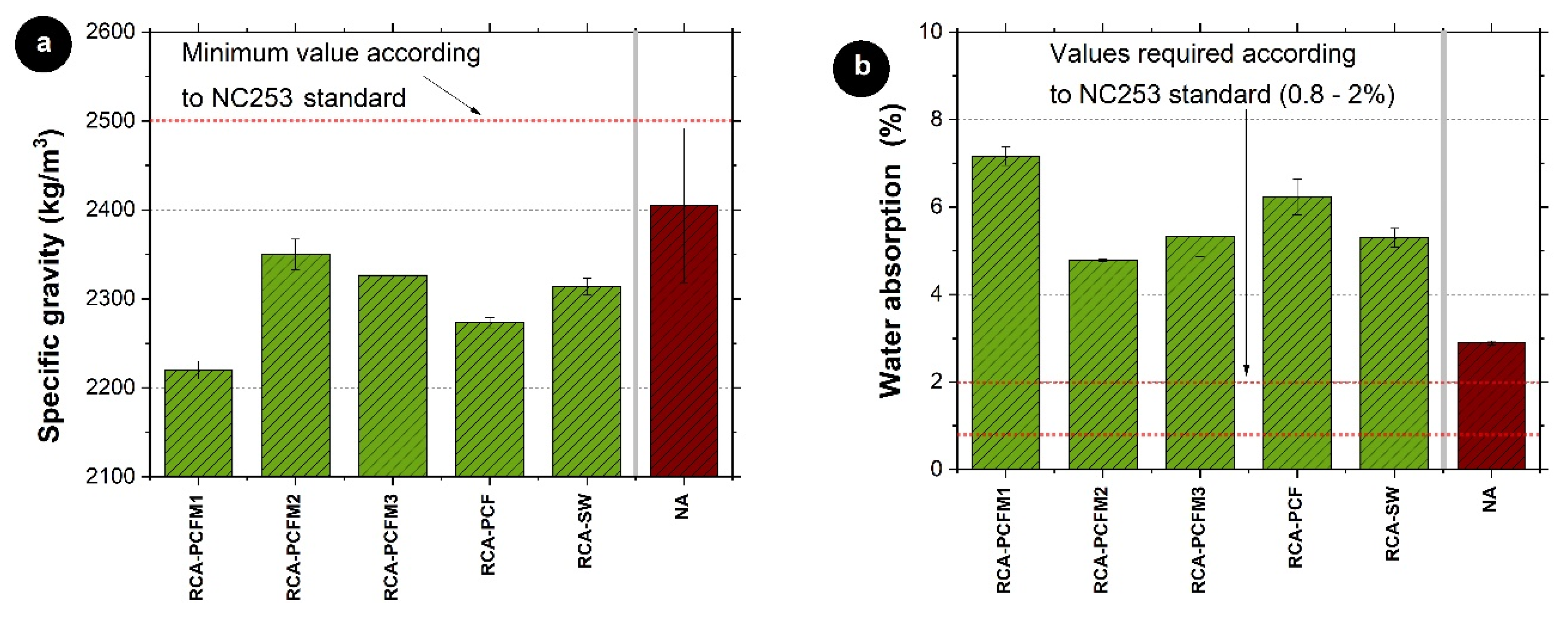
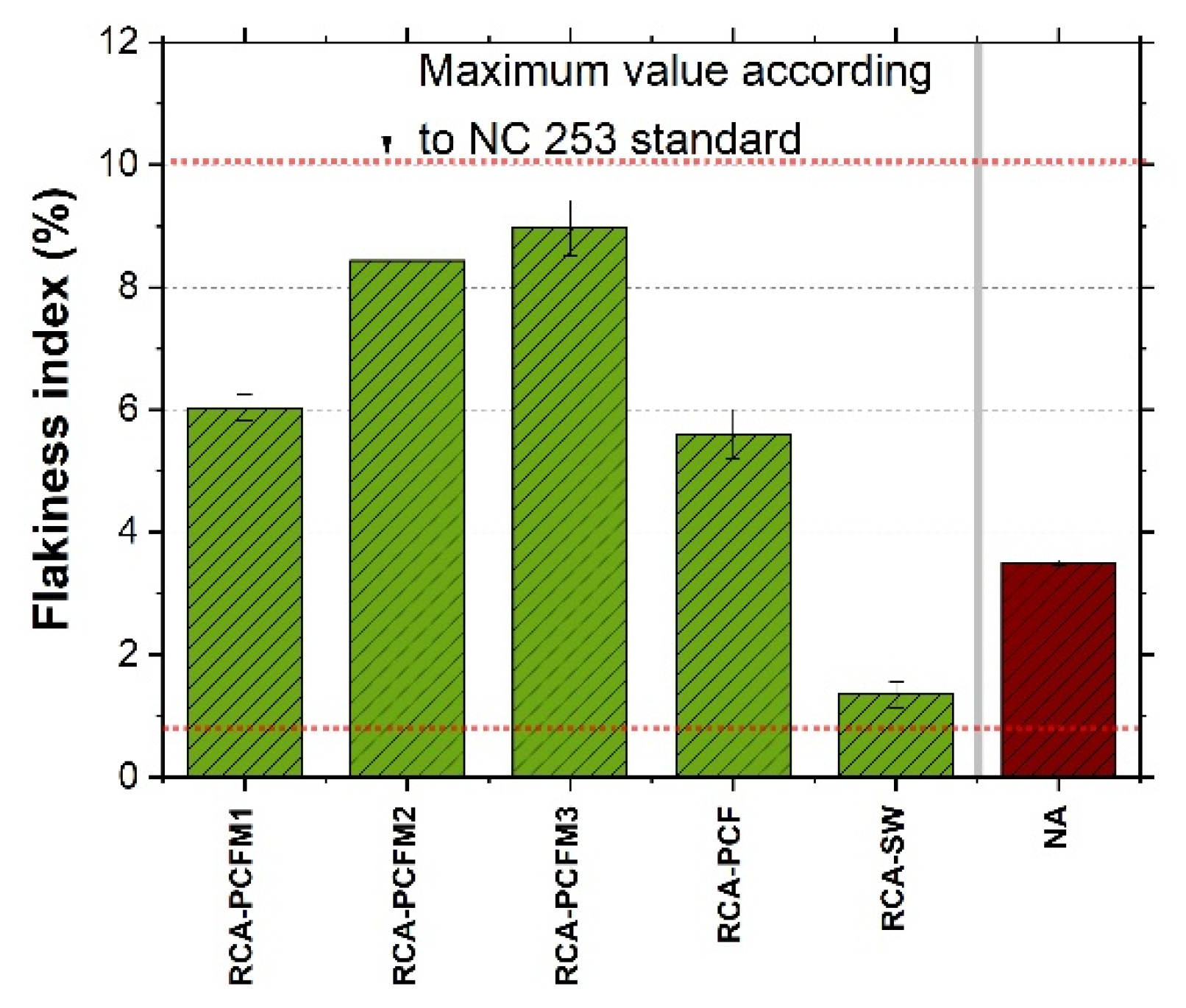
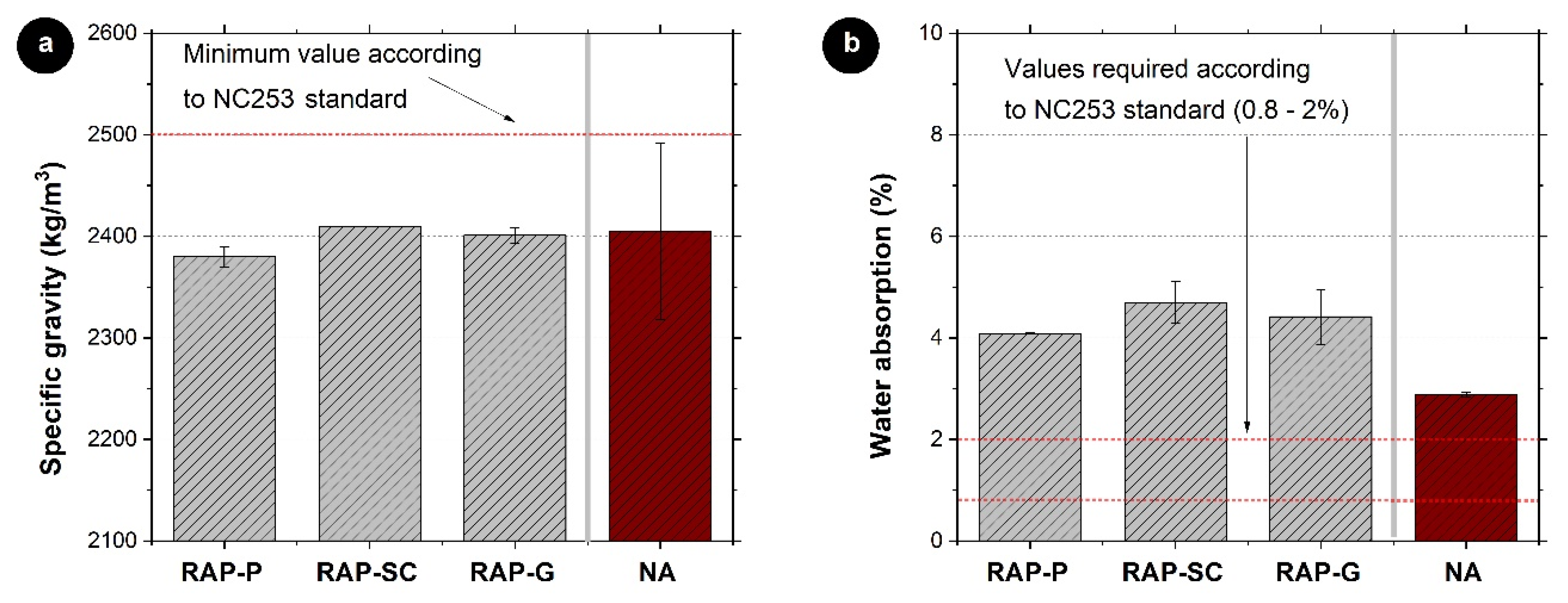
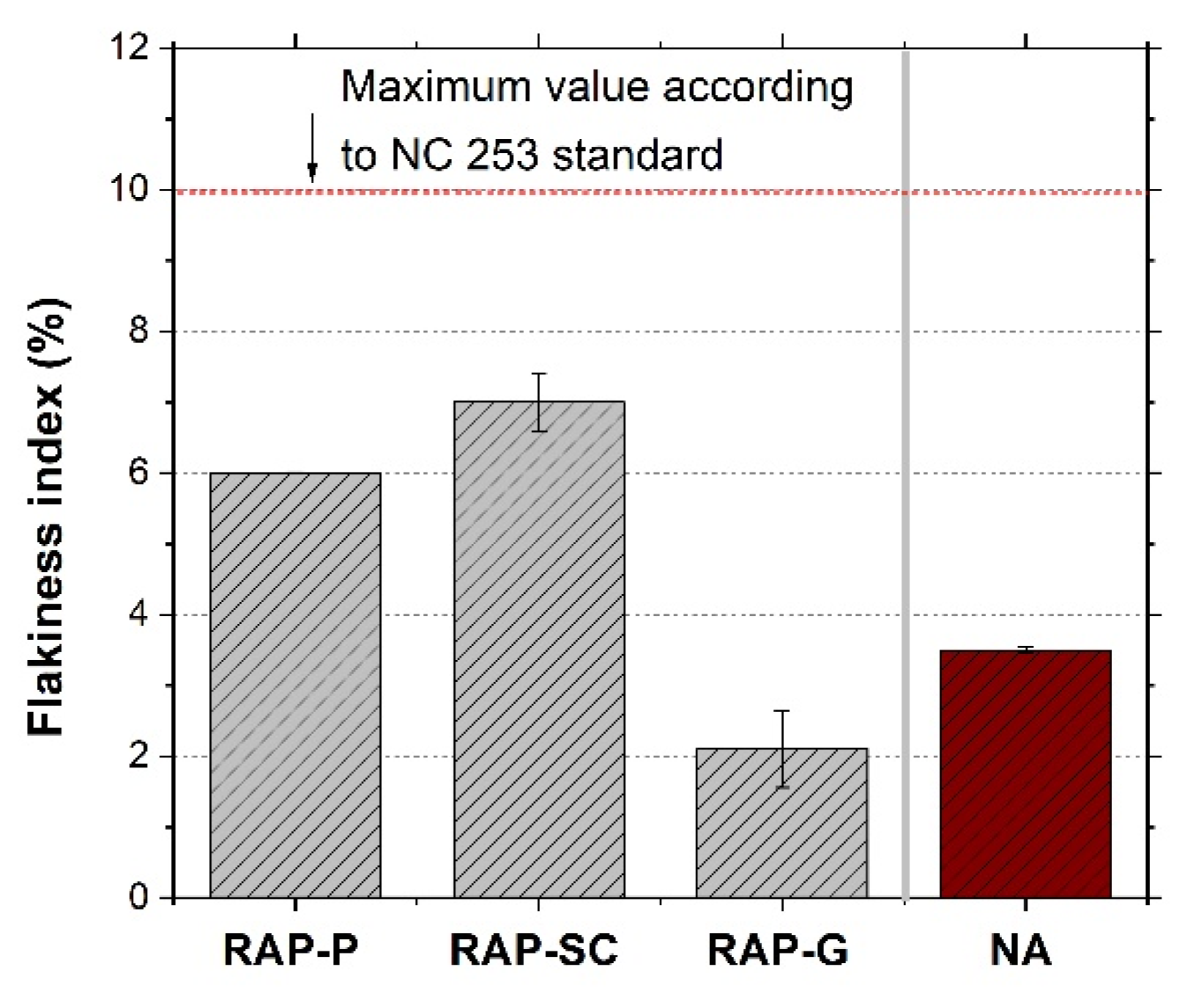
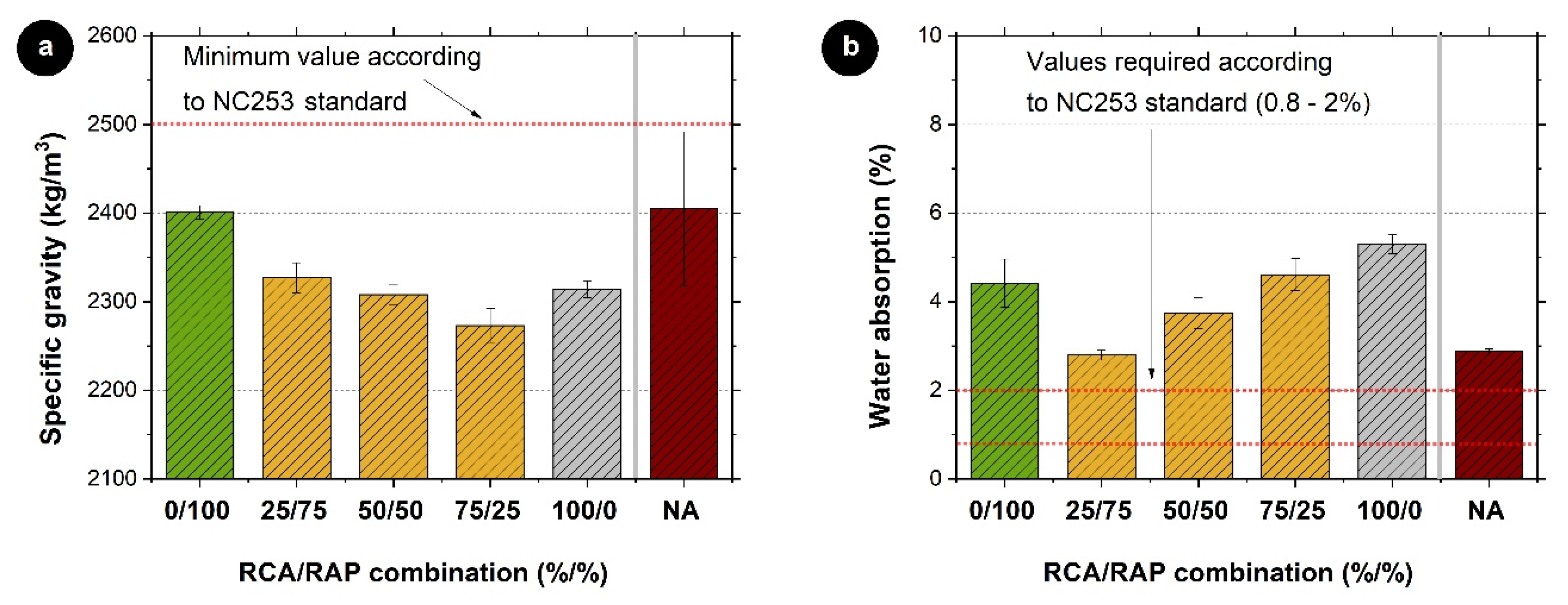
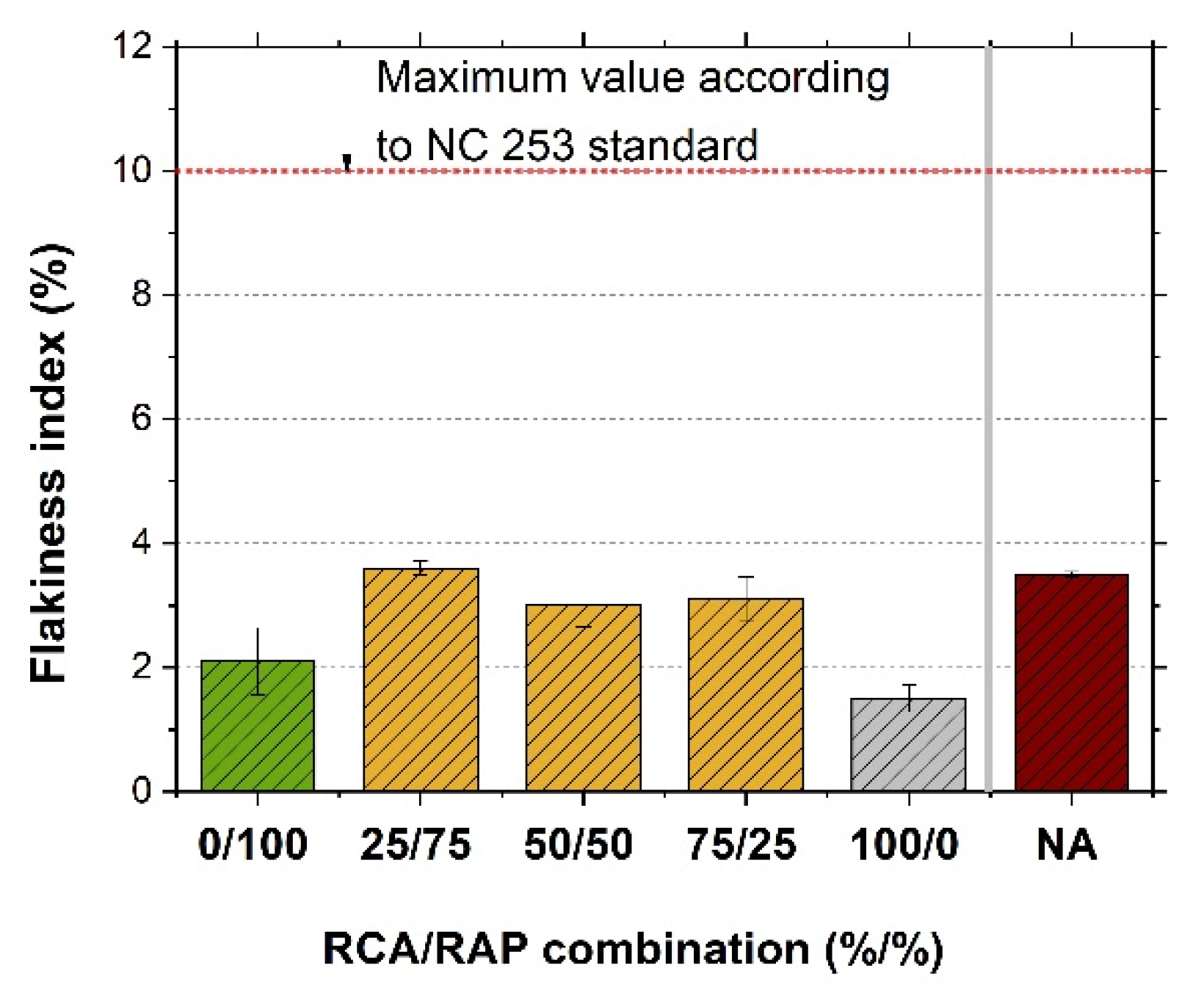
| Sample | ID. | RCA (Recycled Concrete Aggregates) and RAP (Reclaimed Asphalt Pavement) Source | Process |
|---|---|---|---|
| 1 | RCA-PCFM1 | Remaining concrete from the manufacturing site of the slabs | Sieved 5–10 mm |
| 2 | RCA-PCFM2 | Crushed the remaining material > 10 mm and after sieved 5–10 mm | |
| 3 | RCA-PCFM3 | Crushed and sieved 5–10 mm | |
| 4 | RCA-PCF | Waste from reinforced concrete precast core floor slabs | Crushed and sieved 5–10 mm |
| 5 | RCA-SW | Waste from sidewalk | Crushed and sieved 5–10 mm |
| 6 | RAP-P | Reclaimed asphalt pavement (RAP) | Milling of Primelles Avenue and sieved 5–10 mm |
| 7 | RAP-SC | Milling of Santa Catalina Avenue and sieved 5–10 mm | |
| 8 | RAP-G | Pavement milling collected from Guanabacoa plant and sieved 5–10 mm |
| Oxides | RCA-PFC | RCA-SW |
|---|---|---|
| Na2O | 0.26 | 0.240 |
| MgO | 6.12 | 4.688 |
| Al2O3 | 1.38 | 2.203 |
| SiO2 | 5.98 | 8.226 |
| SO3 | 0.50 | 0.085 |
| K2O | 0.22 | 0.738 |
| CaO | 39.09 | 42.296 |
| Fe2O3 | 0.76 | 1.332 |
| TiO2 | -- | 0.184 |
| SrO | -- | 0.187 |
| BaO | -- | 0.604 |
| Source | Moisture Content (%) According to NTL-359/87 [42] | Typical Range of Values According to [44] | Asphalt Content (%) According to NLT-164/90 [43] | Typical Range of Values According to [44] |
|---|---|---|---|---|
| RAP-P | 5.93 | Normal: 4.5–6% Maximum 3–7% | 1.48 | Normal: ≤ 5% Maximum 7–8% |
| RAP-SC | 5.14 | 1.51 | ||
| RAP-G | 4.63 | 1.86 |
| NA | RCA | RAP | RCA/RAP | ||||||||||||
|---|---|---|---|---|---|---|---|---|---|---|---|---|---|---|---|
| PCFM1 | PCFM2 | PCFM3 | PCF | SW | P | SC | G | 0/100 | 25/75 | 50/50 | 75/25 | 100/0 | |||
| NA | |||||||||||||||
| RCA | PCFM1 | ● | ● | ● | ● | ● | ● | ● | ● | ● | ● | ||||
| PCFM2 | ● | ||||||||||||||
| PCFM3 | |||||||||||||||
| PCF | ● | ● | ● | ● | ● | ||||||||||
| SW | ● | ● | ● | ● | ● | ||||||||||
| RAP | P | ● | ● | ● | ● | ● | ● | ||||||||
| SC | ● | ● | ● | ● | ● | ● | |||||||||
| G | ● | ● | ● | ● | ● | ● | |||||||||
| RCA/RAP | 0/100 | ● | ● | ● | ● | ● | ● | ||||||||
| 25/75 | ● | ||||||||||||||
| 50/50 | ● | ● | ● | ● | ● | ||||||||||
| 75/25 | ● | ● | ● | ● | |||||||||||
| 100/0 | ● | ● | ● | ● | ● | ||||||||||
| NA | RCA | RAP | RCA/RAP | ||||||||||||
|---|---|---|---|---|---|---|---|---|---|---|---|---|---|---|---|
| PCFM1 | PCFM2 | PCFM3 | PCF | SW | P | SC | G | 0/100 | 25/75 | 50/50 | 75/25 | 100/0 | |||
| NA | ● | ● | ● | ● | ● | ● | |||||||||
| RCA | PCFM1 | ● | ● | ● | ● | ● | ● | ● | ● | ● | |||||
| PCFM2 | ● | ● | ● | ● | |||||||||||
| PCFM3 | |||||||||||||||
| PCF | ● | ● | ● | ||||||||||||
| SW | ● | ● | ● | ||||||||||||
| RAP | P | ● | ● | ● | ● | ||||||||||
| SC | ● | ||||||||||||||
| G | |||||||||||||||
| RCA/RAP | 0/100 | ||||||||||||||
| 25/75 | ● | ● | ● | ● | ● | ● | |||||||||
| 50/50 | ● | ● | |||||||||||||
| 75/25 | ● | ||||||||||||||
| 100/0 | ● | ● | ● | ||||||||||||
| NA | RCA | RAP | RCA/RAP | ||||||||||||
|---|---|---|---|---|---|---|---|---|---|---|---|---|---|---|---|
| PCFM1 | PCFM2 | PCFM3 | PCF | SW | P | SC | G | 0/100 | 25/75 | 50/50 | 75/25 | 100/0 | |||
| NA | |||||||||||||||
| RCA | PCFM1 | ||||||||||||||
| PCFM2 | |||||||||||||||
| PCFM3 | |||||||||||||||
| PCF | |||||||||||||||
| SW | |||||||||||||||
| RAP | P | ● | ● | ● | ● | ● | ● | ||||||||
| SC | ● | ● | ● | ● | ● | ||||||||||
| G | ● | ● | |||||||||||||
| RCA/RAP | 0/100 | ● | ● | ||||||||||||
| 25/75 | ● | ● | ● | ||||||||||||
| 50/50 | ● | ● | |||||||||||||
| 75/25 | ● | ● | |||||||||||||
| 100/0 | ● | ● | ● | ● | |||||||||||
© 2020 by the authors. Licensee MDPI, Basel, Switzerland. This article is an open access article distributed under the terms and conditions of the Creative Commons Attribution (CC BY) license (http://creativecommons.org/licenses/by/4.0/).
Share and Cite
Morales Fournier, J.; Acosta Álvarez, D.; Alonso Aenlle, A.; Tenza-Abril, A.J.; Ivorra, S. Combining Reclaimed Asphalt Pavement (RAP) and Recycled Concrete Aggregate (RCA) from Cuba to Obtain a Coarse Aggregate Fraction. Sustainability 2020, 12, 5356. https://doi.org/10.3390/su12135356
Morales Fournier J, Acosta Álvarez D, Alonso Aenlle A, Tenza-Abril AJ, Ivorra S. Combining Reclaimed Asphalt Pavement (RAP) and Recycled Concrete Aggregate (RCA) from Cuba to Obtain a Coarse Aggregate Fraction. Sustainability. 2020; 12(13):5356. https://doi.org/10.3390/su12135356
Chicago/Turabian StyleMorales Fournier, Jessika, Debora Acosta Álvarez, Anadelys Alonso Aenlle, Antonio José Tenza-Abril, and Salvador Ivorra. 2020. "Combining Reclaimed Asphalt Pavement (RAP) and Recycled Concrete Aggregate (RCA) from Cuba to Obtain a Coarse Aggregate Fraction" Sustainability 12, no. 13: 5356. https://doi.org/10.3390/su12135356
APA StyleMorales Fournier, J., Acosta Álvarez, D., Alonso Aenlle, A., Tenza-Abril, A. J., & Ivorra, S. (2020). Combining Reclaimed Asphalt Pavement (RAP) and Recycled Concrete Aggregate (RCA) from Cuba to Obtain a Coarse Aggregate Fraction. Sustainability, 12(13), 5356. https://doi.org/10.3390/su12135356







